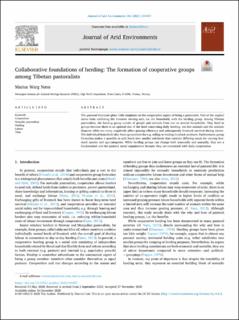| dc.contributor.author | Næss, Marius Warg | |
| dc.date.accessioned | 2021-03-03T10:31:01Z | |
| dc.date.available | 2021-03-03T10:31:01Z | |
| dc.date.created | 2021-02-23T10:23:13Z | |
| dc.date.issued | 2021 | |
| dc.identifier.issn | 0140-1963 | |
| dc.identifier.uri | https://hdl.handle.net/11250/2731349 | |
| dc.description.abstract | The pastoral literature place little emphasis on the cooperative aspect of being a pastoralist. Part of the neglect stems from conflating the livestock owning unit, i.e. the household, with the herding group. Among Tibetan pastoralists, the herding group consist of people and animals from one or several households. They herd in groups because there is an optimal size of the herd concerning daily herding: too few animals and the animals disperse while too many negatively affect grazing efficiency and subsequently livestock survival during winter. The individual household also frees up members for e.g. selling or trading livestock products. Furthermore, group formation makes it possible to split herds into smaller sub-herds that consider differing needs for varying livestock species and age-categories. While herding groups can change both seasonally and annually, they are a fundamental unit for pastoral social organisation because they are concerned with daily cooperation. | en_US |
| dc.language.iso | eng | en_US |
| dc.title | Collaborative foundations of herding: The formation of cooperative groups among Tibetan pastoralists | en_US |
| dc.type | Peer reviewed | en_US |
| dc.type | Journal article | en_US |
| dc.description.version | publishedVersion | en_US |
| dc.source.volume | 186 | en_US |
| dc.source.journal | Journal of Arid Environments | en_US |
| dc.source.issue | 104407 | en_US |
| dc.identifier.doi | https://doi.org/10.1016/j.jaridenv.2020.104407 | |
| dc.identifier.cristin | 1892652 | |
| dc.relation.project | Norges forskningsråd: 240280 | en_US |
| dc.relation.project | Nordforsk: 76915 | en_US |
| dc.relation.project | Framsenteret: 369910 | en_US |
| cristin.ispublished | true | |
| cristin.fulltext | original | |
| cristin.qualitycode | 1 | |
